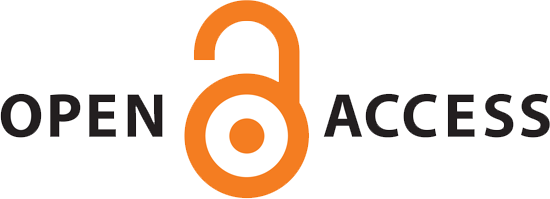In Vivo Biocompatibility of Dental Bonding Agents containing Colloidal Dispersion of Titanium Dioxide
Abstract
Purpose: To investigate the direct and indirect cytotoxic effects of two universal dental bonding agents incorporated with titanium oxide colloidal dispersion on a human gingival fibroblast cell.
Materials and Methods: Two commercial dental bonding agents’ systems, i.e., Ambar universal (FGM, Brasil) and G-Premio Bond Universal (GC, America) were incorporated with 4% by mass of colloidal dispersion containing titanium oxide (TiO2) nanoparticles. Human gingival fibroblast cells were used for cytocompatibility analysis. Two cytotoxic assays were used to investigate the cytotoxic activity of four bonding agent groups on the fibroblast-like cells as follows; GA: Ambar Universal (control), GB: Ambar Universal (4% TiO2 incorporated), GC: G-Premio Bond universal (control), and GD: G-Premio Bond (4% TiO2 incorporated). Forty bonding agent samples (5 x 1 mm discs) were prepared from the bonding agent groups and used for 3-(4,5-dimethylthiazolyl-2)-2,5-diphenyltetrazolium bromide (MTT) assay and 32 discs were used for the High-Content Screening (HCS) assay.
Results: The results from the cytotoxic assays showed a high degree of cytocompatibility for all tested bonding agents. However, the incorporated bonding agent Groups (GB and GD) showed significantly less cytotoxic effects than their controls. Also, groups GC and GD showed significantly higher cytocompatibility than GA and GB.
Conclusion: The incorporation of 4% by mass of colloidal dispersion of titanium oxide nanoparticles significantly enhanced the biocompatibility of the tested universal bonding agents in comparison to their control groups.
2- Oner Ozdemir, "Cell-Mediated Cytotoxicity Assays." Asthma Allergy Immunology, Vol. 17 (No. 2), pp. 61-69, (2019).
3- Shuaizhang Li and Menghang Xia, "Review of high-content screening applications in toxicology." Archives of Toxicology, Vol. 93 (No. 12), pp. 3387-96, 2019/12/01 (2019).
4- Eshrak Sofan, Afrah Sofan, Gaspare Palaia, Gianluca Tenore, Umberto Romeo, and Guido Migliau, "Classification review of dental adhesive systems: from the IV generation to the universal type." Annali di Stomatologia, Vol. 8 (No. 1), pp. 1-17, (2017).
5- Ali Jabbar Al-Sarray, Israa M. Al-Mussawi, Taghreed H. Al-Noor, and Yousif Abu-Zaid, "Organo-Clay Composites of Intercalated 4-Methylaniline and Its Schiff Base Derivative: Preparation and Characterization." Journal of Medicinal and Chemical Sciences, Vol. 5 (No. 6), pp. 1094-101, (2022).
6- Kumiko Yoshihara et al., "Effectiveness and stability of silane coupling agent incorporated in ‘universal’ adhesives." Dental Materials, Vol. 32 (No. 10), pp. 1218-25, 2016/10/01/ (2016).
7- Ali J. A. Al-Sarray, Tarik Al-Kayat, Borhan Mustafa Mohammed, Mohammed Jassim Bader Al-assadi, and Yousif Abu-Zaid, "Dielectric and Electrical Properties of Intercalated 1-(4-nitrophenyl)-N-(p-tolyl) methanimine into the Interlayers of Bentonite Clay." Journal of Medicinal and Chemical Sciences, Vol. 5 (No. 7 (Special Issue)), pp. 1321-30, (2022).
8- Jaison Jeevanandam, Ahmed Barhoum, Yen S. Chan, Alain Dufresne, and Michael K. Danquah, "Review on nanoparticles and nanostructured materials: history, sources, toxicity and regulations." Beilstein Journal of Nanotechnology, Vol. 9pp. 1050-74, (2018).
9- Alexandros Besinis, Tracy De Peralta, and Richard D. Handy, "The antibacterial effects of silver, titanium dioxide and silica dioxide nanoparticles compared to the dental disinfectant chlorhexidine on Streptococcus mutans using a suite of bioassays." Nanotoxicology, Vol. 8 (No. 1), pp. 1-16, 2014/02/01 (2014).
10- Mohammed Ali Fadhil Al-Abd Al-Abbas, Rafid Jihad Al-Badr, and Muaid S Abbas Shamash, "Long-term water sorption/solubility of two dental bonding agents containing a colloidal dispersion of titanium dioxide." (in eng), Journal of Advanced Pharmaceutical Technology & Research, Vol. 14 (No. 2), pp. 142-46, (2023).
11- Stefan Paul, Oliver Hanisch, and Dobrila Nesic, "Human Gingival Fibroblast Proliferation on Materials Used for Dental Implant Abutments: A Systematic Review." International Journal of Prosthodontic, Vol. 34 (No. 6), pp. 811-28, NOV-DEC (2021).
12- Cristina Espinar, Alvaro Della Bona, María M. Pérez, and Rosa Pulgar, "Color and optical properties of 3D printing restorative polymer-based materials: A scoping review." Journal of Esthetic and Restorative Dentistry, Vol. 34 (No. 6), pp. 853-64, 2022/09/01 (2022).
13- Yuta Tsugeno, Fuyuki Sato, Yasuteru Muragaki, and Yukio Kato, "Cell culture of human gingival fibroblasts, oral cancer cells and mesothelioma cells with serum‑free media, STK1 and STK2." Biomedical Reports, Vol. 2 (No. 5), pp. 644-48, 2014/09/01 (2014).
14- Amandine Bastide, Jonathan W. Yewdell, and Alexandre David, "The RiboPuromycylation Method (RPM): an Immunofluorescence Technique to Map Translation Sites at the Sub-cellular Level." Bio-protocol, Vol. 8 (No. 1), p. e2669, 2018/01/05 (2018).
15- P. Moutsatsou, K. Coopman, and S. Georgiadou, "Biocompatibility Assessment of Conducting PANI/Chitosan Nanofibers for Wound Healing Applications." POLYMERS, Vol. 9 (No. 12), (2017), Art no. 687.
16- Zahra Nozhat, Mina S. Khalaji, Mehdi Hedayati, and Sima Kheradmand Kia, "Different Methods for Cell Viability and Proliferation Assay: Essential Tools in Pharmaceutical Studies." Anti-Cancer Agents in Medicinal Chemistry, Vol. 22 (No. 4), pp. 703-12, (2022).
17- Madalina S. Baltatu, Cristiana Chiriac-Moruzzi, Petrica Vizureanu, László Tóth, and János Novák, "Effect of Heat Treatment on Some Titanium Alloys Used as Biomaterials." Applied Sciences. Vol. 12 (No. 21). DOI: 10.3390/app122111241
18- Andrew Zane et al., "Biocompatibility and antibacterial activity of nitrogen-doped titanium dioxide nanoparticles for use in dental resin formulations." International Journal of Nanomedicine, Vol. 11pp. 6459-70, 2016/12/31 (2016).
19- Chengzhu Liao, Yuchao Li, and Sie C. Tjong, "Visible-Light Active Titanium Dioxide Nanomaterials with Bactericidal Properties." Nanomaterials. Vol. 10 (No. 1). DOI: 10.3390/nano10010124
20- Codruta Sarosi et al., "Effects of Monomer Composition of Urethane Methacrylate Based Resins on the C=C Degree of Conversion, Residual Monomer Content and Mechanical Properties." POLYMERS. Vol. 13 (No. 24). DOI: 10.3390/polym13244415
| Files | ||
| Issue | Vol 12 No 2 (2025) | |
| Section | Original Article(s) | |
| DOI | https://doi.org/10.18502/fbt.v12i2.18271 | |
| Keywords | ||
| Universal Bonding Agents Colloidal Dispersion Titanium Oxide Cytocompatibility | ||
| Rights and permissions | |

|
This work is licensed under a Creative Commons Attribution-NonCommercial 4.0 International License. |




